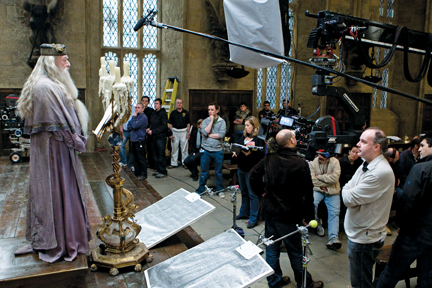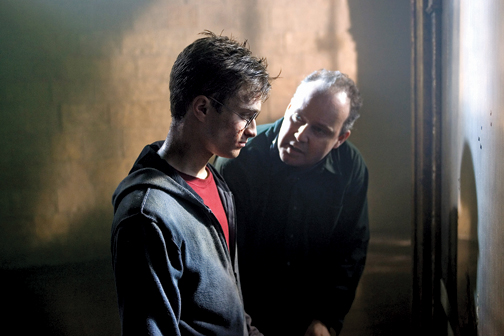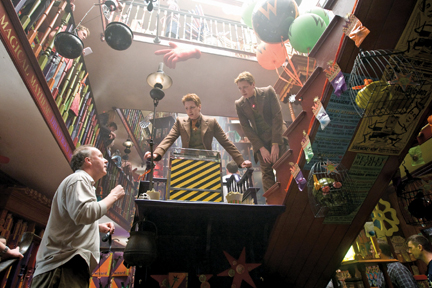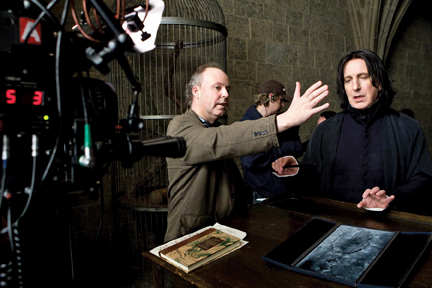BY ANDREW PULVER
 THE BIG PICTURE: Yates says his goal was to make Potter realer "because
THE BIG PICTURE: Yates says his goal was to make Potter realer "because
then the magic feels more extraordinary." (Credit: Warner Bros. Inc.) Yates directs Michael Gambon in the mail hall at Hogwarts. (Credit: Everett Collection)
Yates directs Michael Gambon in the mail hall at Hogwarts. (Credit: Everett Collection)I have lived and breathed and slept Potter for five or six years now," says director David Yates. "Anyone who makes a movie like this has to commit themselves to it completely. You become absorbed in the minutiae of it. It becomes your life, and your crew becomes your family. There's no shortcut; you can't switch off at 5 o'clock. You have to finish it. You want it to be right."
So says the man charged with arguably the biggest task in cinema right now: directing — at the same time — the final two installments of the Harry Potter series, The Deathly Hallows: Parts I and II. "Everyone has been working their socks off for such a long time," he continues. "Not just me, but everyone on the crew: the DP, the designer, the costume and makeup people. What keeps us going is the adrenaline and the excitement of doing it, and the fact so many people are waiting for the film."
The project is genuinely mammoth. Yates rules over Potter's expansive kingdom at Leavesden Studios, a former airstrip and factory operated by Rolls-Royce, just to the north of London that has served as home to the franchise since 2001. The cluster of former hangars now houses a model shop, plasterers, an electronics workshop, and acre after acre of standing sets. There's a 15-foot-tall likeness of Hagrid, standing in front of a scarily authentic-looking, three-quarter-sized model of Potter himself; the half-completed portal to the Ministry of Magic (modeled after the infamous public toilets on London's Hampstead Heath); the skeletal vaults of Gringott's bank; the lobby of Malfoy's mansion, which is decorated with portraits whose faces belong to crew members. The pièce de résistance, and the only permanent set, is the main hall of Hogwarts. The soaring Gothic vaulting and delicate tracery are in place, but the room is now empty except for rigged-up fire-drapes, left behind when the room was trashed for the Deathly Hallows' climactic battle sequence.
Yates says he started shooting over a year ago, and "it's a bit vague, to be honest, as it's been going on for such a long time" and expects to be at it until May. And to add to the confusion, any kind of chronological shooting is impossible with so many name actors involved. "Right now, one-and-a-half films are in the can, as it were; we've got about half a film to go. I'm constantly editing, and constantly shooting. Normally, when you're shooting, you have a very intense time frame to get things done, but this rolls on and on and on. You have this weird experience of editing something you shot a year ago, and knowing that it's part of a sequence that won't be finished for another year. I'm basically on a real marathon.
Yates, who started out not that long ago making quality films and TV for British television, cuts an unlikely figure as the commanding general of this multi-billion dollar cinematic empire, deploying vast resources both material and financial, and calling on the whole range of filmmaking technique from cutting-edge computer systems to old-style puppetry. He's an unassuming, soft-spoken Englishman in his late 40s who likes to think of himself as the "conductor" of the production. Exactly how does he grapple with the industrial scale of it all? "These films are huge machines. I have hundreds of people—and if you take in postproduction houses, thousands—working to deliver them. You need to have a very clear sense of where you're going and what you want. For me, being a director is about bringing the best out of people — it's about nurturing and developing relationships, to make someone better than they would be if you weren't working with them.
"In terms of directorial style," he adds, "I've never been a shouter. It's often the quiet word, and enthusiasm and passion for where you want to go, that works, rather than dragging people with you. That's what I prefer to do, anyway."
It's not often that a director is able to talk about a project midway through a shoot, but with Potter's attenuated schedule, it's an ideal opportunity to see the day-to-day grind of making a $300-million double movie. Yates can take the time out because, he explains, the main unit isn't shooting now; the primary activity is second unit and editing. (On the Potter films, the second unit handles all the effects shots.) So what did the director of a Harry Potter film actually do today? Yates ticks off his activities on his fingers: "Well, I've been editing for about six hours. It's a big, complicated sequence in part 2, toward the end of the film, with Ralph Fiennes. While I'm doing that I've been keeping an eye on the second unit. They're shooting a little scene in Gringott's that also takes place in part 2. So I go down to the set, eye up the shot, then come back to the editing room and watch the shot on a monitor as it's being played out.
"Then we've been going around looking at bits of set we need to hold on to, because I need an extra shot for a scene I shot six weeks ago. We've also been looking at some color grading of a scene that we're going to shoot in three weeks' time; we've been doing some camera tests and looking at where we're going to pitch the look of the scene."
Because of the Potter films' aversion to revealing any plot details ahead of time, Yates is reticent about offering any specifics of how he might make creative decisions one way or another, or on solving particular problems. He is, however, revealing about how he and his team go about developing concepts for individual scenes. "Today," he says, "I've had meetings about giants. We're looking at how we make our giants extraordinary and different. We've been looking at makeup and costume design, and how we manipulate features on the interesting-looking people we've found. Do we do prosthetics or digital manipulation, or a combination of the two?"
For Yates, it's been an extraordinary ascension. When he was picked to direct Harry Potter and the Order of the Phoenix, he was about as far from being a safe pair of hands at the helm as you could imagine. With next to no feature film experience, he was completely untested, certainly compared to his predecessorsChris Columbus, Mike Newell and Alfonso Cuarón. Yates did, however, have a stack of award-winning dramas for British TV on his CV: the political thriller State of Play (2003) (recently remade as an American feature); the Victorian social satire The Young Visiters [sic] (2003); the tough prostitution drama Sex Traffic (2004); and the Richard Curtis-scripted political comedy The Girl in the Café (2005), which HBO picked up.
Yates said he was reluctant to embark on a feature film project for the sake of it. He thought: "Do I want to make a really average movie, or spend six months turning 'round something really exciting or smart like State of Play or Sex Traffic?" Then midway though editing the latter, he got what he calls a "mad phone call from my agent, asking, would I ever think about doing a Harry Potter?" As Yates tells it, he was initially resistant. "I said, why would I want to do that? It's already been done by three directors, there's no world to create. She said it's the biggest film in the world, and you'll never get a chance like this again." So he met producer David Heyman and liked him, and realized, "I'd be crazy not to do it. Heyman and [producer] David Barron were very graceful and told me they were talking to some other 'quite important' directors; but it just transpired I ended up directing it.'"
 MAGIC:Yates brings out the serious side of Daniel Radcliffe as Potter.
MAGIC:Yates brings out the serious side of Daniel Radcliffe as Potter. A scene in the joke shop.
A scene in the joke shop. Yates directs Alan Rickman as the dark arts Professor.
Yates directs Alan Rickman as the dark arts Professor. Working with Potters' best friends played by Rupert Grint and Emma Watson.
Working with Potters' best friends played by Rupert Grint and Emma Watson.
(Photo Credits: Warner Bros., Inc./Everett Collection)But, what did the director of tough, edgy TV drama have that appealed to the producers of an intricately plotted kids' fantasy adventure? "I think they wanted to do a Harry Potter that felt realer, and more grown up. What's smart about the studio and the producers is they have always wanted to push it a bit. Chris [Columbus] did a wonderful job of casting and making this world incredibly popular. But rather than do more of the same, they said, 'Let's bring in Alfonso Cuarón and let him run with it. Then later, let's bring in David Yates, who's done all this hard-hitting stuff on TV. It's a testament to their ambition to try and keep the franchise fresh. The bizarre thing is, I did one and they asked me to stay for three more, so obviously they liked something."
Suddenly having to deal with a panoply of visual effects and fantasy—green screen, animatronics, CGI—surely must have been difficult. Still, there were skills he had learned directing TV he could apply to Potter. "Ultimately you apply the same process to anything you direct: Do I believe it? Does it tell the story? Does it enchant or intrigue me? You ask all the same questions of a bit of visual effects as you would ask of a bit of performance, or a bit of writing, or a bit of music. It's just an extension of your imagination, projecting what you know will be there."
After he took the job, Yates says he took Mike Newell, who was still working on Goblet of Fire, out to the pub and "picked his brains about what it was going to be like to step into someone's shoes on a movie of this scale." Even if he was initially intimidated, says Yates, he found himself taking to Potter "like a duck to water."
"But it was hard to begin with, if I'm being honest. The first big sequence I did on Phoenix was a scene with a giant. On set, the giant was just a bloke running around with a big pole. It was jumping in at the deep end. But I learned very fast and now have a fluidity and flexibility with the camera; I know I can throw it around and chuck things away if they don't work. I feel a lot more confident about the process. I got my legs very quickly."
Yates has also learned to be the ultimate diplomat, clearly a necessary skill when dealing with an anxious studio at one end and fanatic fandom at the other. He says he's had no interference from Warner Bros. in over a year. "They've visited once for about two hours. It was very pleasant." He says no one from Hollywood gives him notes—at least not during the shoot. "When we get into post, it's slightly different. The film is tested and that's when there's more of a full engagement. That's when they'll have notes and thoughts, concerns and enthusiasms. But that's the same as everything I've ever made. Ultimately, the people who have financed it and will put it out have questions. You engage them in the process and try and take them with you. Even though these are huge films, I feel I have absolute freedom."
Yates is also mindful of the legions of devoted fans, all waiting to jump if a favorite character or scene is cut. "At one point, when I was making Phoenix, I thought: 'God, what if I'm the director who drops the ball?' You don't want to be the one who mucks it up.
"Look, I'd put everything in if I had the time and the money, but I don't. I have to serve the form I'm working in—a two or two-and-a-half-hour film. You have to serve that shape, that rhythm, that pace. You want to retain the tonality of what's in the book; that's incredibly important because that's why these stories are so popular. But at the end of the day, you can't second-guess what everyone else wants. You'd drive yourself mad. So I find things that I respond to in the material and pursue that. In Order of the Phoenix it was Harry's isolation and anger. I stripped out all those lovely subplots down to a clear through line; you could follow his story and feel for him. In Half-Blood I adored the sexual and emotional politics. But it's obviously a job where you're going to get kicked. I can deal with that."
And in spite of the size of the endeavor, Yates feels he's still able to a put a genuine directorial stamp on the films. "Every day I make a decision that affects the tenor or tone of a scene. I think I've been most interested in bringing an emotional reality to the stories, pulling it slightly away from fantasy. I love fantasy, by the way, and the final film in particular has a lot. But the reason why I think the fifth Potter film was so successful, and they pulled me in for the sixth, was because I wanted to believe in these characters, to have them get complicated, and grow older. My stamp is to make the stories rawer and realer, because then the magic feels more extraordinary."
Yates admits Harry Potter is a tough act to follow. He says that the first thing he's going to do when it's over is take six months off. "I will have been in production for seven straight years, which is ridiculous." What he's looking to do once he comes back to work is "checkerboard"—alternating big, spectacle movies with what he calls "smaller, bespoke European films." He pauses for a rare moment of reflection, seemingly catching his breath. "I've not had time between Potters to do anything. As soon as I finish a Potter I'm editing another Potter and preparing the next Potter. But I'm not wishing this away; I love Potter and am really proud of it. But I am looking forward to the future, even if it's still a couple of years away."